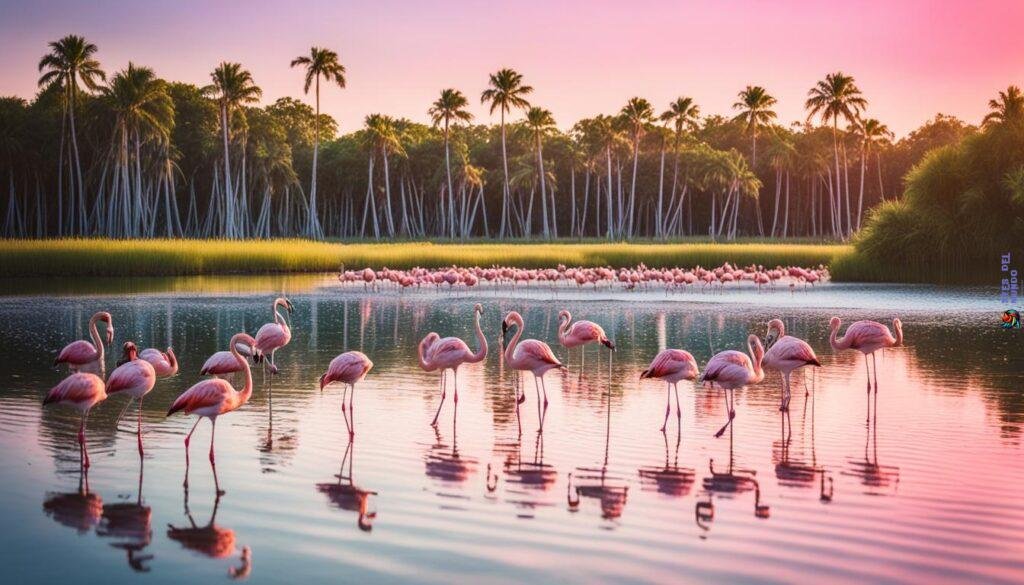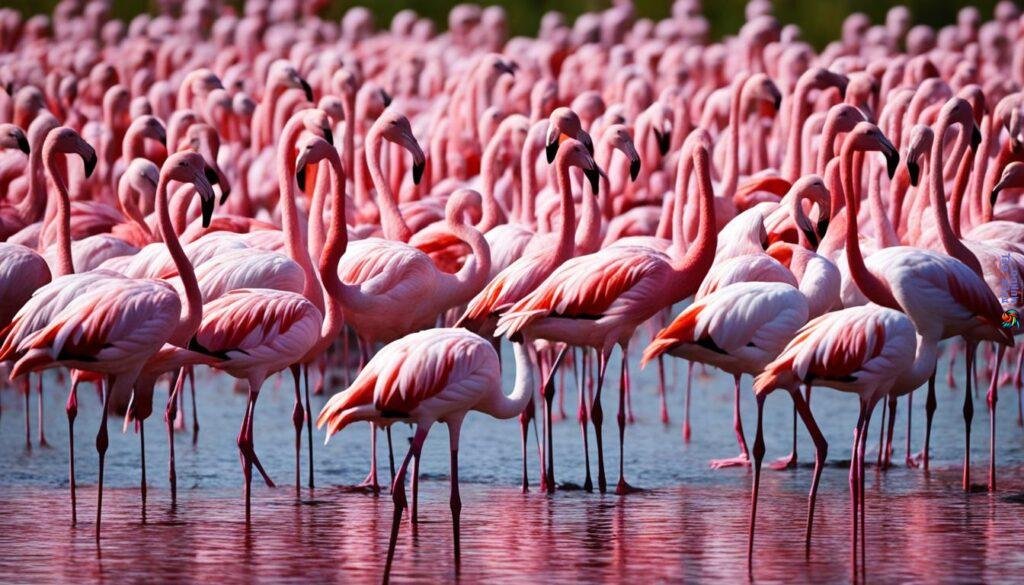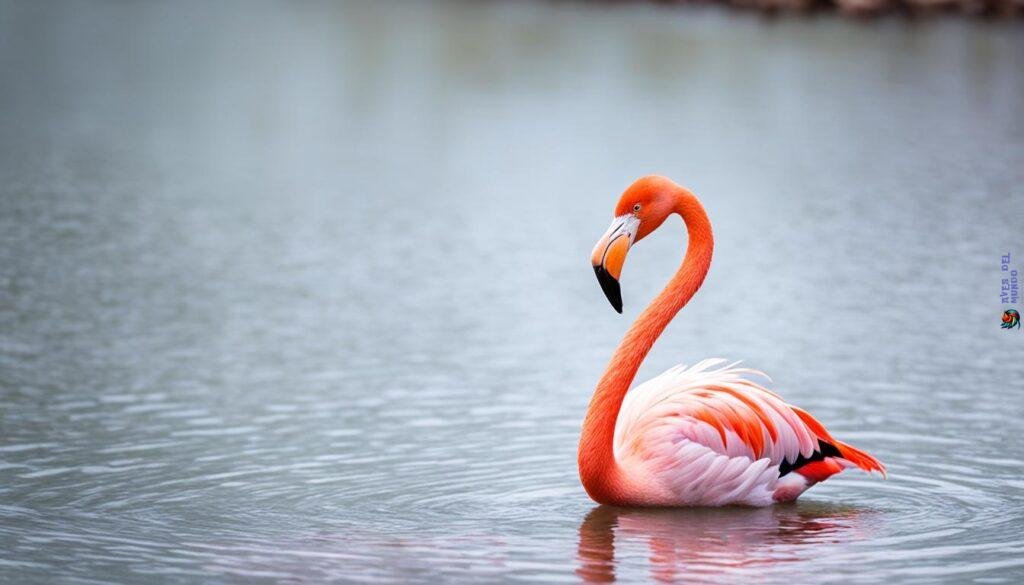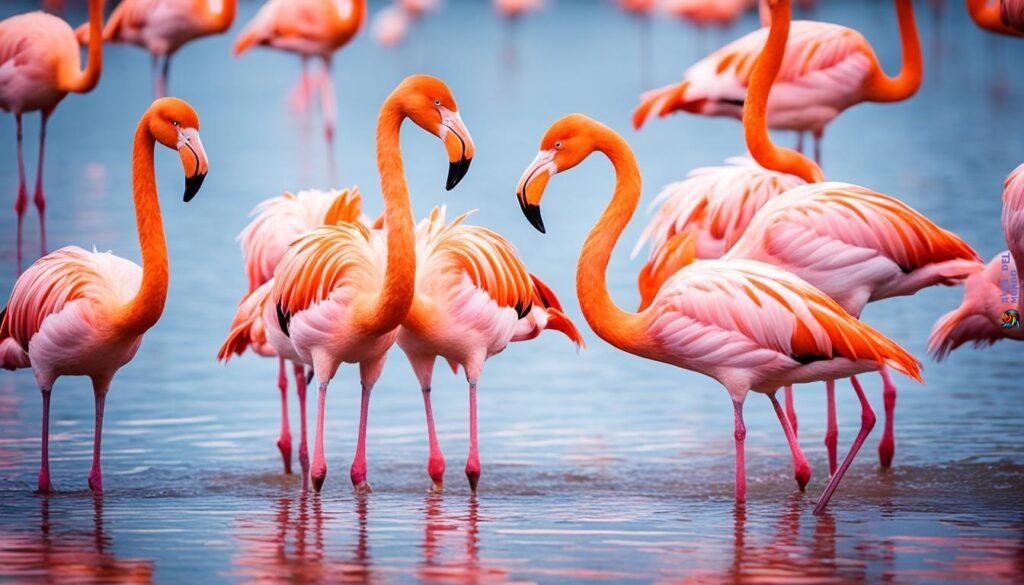Flamingos are one of the most exotic-looking birds in the animal kingdom. They are known for their vibrant pink hue, long legs, and distinctive behavior. There are six known species of flamingos, including the greater flamingo, lesser flamingo, and American flamingo. They are usually found in swamps and mudflats and are classified as waders, which are long-legged birds found on bodies of water. Flamingos have a unique diet, primarily consisting of crustaceans and algae, which gives them their pink coloration. They are non-migratory and live between 20 and 30 years. Flamingos are not endangered and are classified as «least concern» in terms of conservation status.
Key Takeaways:
- Flamingos are vibrant pink birds with long legs and distinct behavior.
- There are six species of flamingos, including the greater flamingo.
- Flamingos are found in swamps and mudflats and are non-migratory.
- Their unique diet of crustaceans and algae gives them their pink coloration.
- Flamingos are not endangered and are classified as «least concern» in terms of conservation status.
Continue reading to discover more intriguing facts about flamingos, including their habitat, behavior, diet, and conservation efforts.
Flamingo Habitat and Behavior
Flamingos are fascinating birds that are typically found in swamps and mudflats, making the most of their unique habitat. These wetland ecosystems provide abundant food sources that sustain the flamingos’ vibrant pink plumage and overall well-being. The rich biodiversity in these areas allows flamingos to feed on crustaceans and algae, which are essential components of their diet.
Aside from their natural habitat, flamingos are known for their captivating behavior. These social birds live in large colonies that can sometimes number in the thousands. Their impressive synchronized movements, such as the famous «head flag,» are a sight to behold. Flamingos also display a distinct behavior of standing on one leg, which is still a mystery to researchers.
Flamingos have a meticulous grooming routine that contributes to their radiant appearance. They possess a special gland that produces oil, which they spread over their feathers during grooming sessions. This process helps to keep their plumage waterproof and structurally sound.
Moreover, flamingos have a complex social structure, forming long-lasting friendships within their flocks. These bonds play a crucial role in various aspects of their lives, including mating, foraging, and protection against predators. Their ability to form meaningful relationships highlights the intelligence and social nature of these remarkable birds.

Flamingos truly exemplify the wonders of nature with their habitat adaptation and captivating behavior. Their unique habitat in wetlands and mudflats provides the perfect ecosystem for them to thrive, ensuring a constant availability of food and shelter. By understanding their habitat and behavior, we gain a deeper appreciation for these incredible creatures.
Flamingo Diet and Feeding Habits
Flamingos have fascinating dietary preferences and feeding habits that contribute to their distinctive appearance. Their diet primarily consists of crustaceans and algae, which contain high levels of carotenoids, pigments responsible for the flamingos’ vibrant pink or reddish coloration.
These mesmerizing birds have developed unique feeding methods to obtain their food. They use their specially adapted curved bills to filter food from mud and water, employing a technique known as filter-feeding. Flamingos use their feet to comb through the mud, stirring up small organisms and other food sources, while their heads are submerged in the water, upside-down.
«The flamingos’ feeding behavior is a captivating sight. Amidst a sea of mud and water, these graceful birds skillfully collect their food, demonstrating their adaptability and efficiency.»
During this process, the flamingos’ beaks and tongues become vital filtering tools. They feature lamellae, which are fine hair-like structures that help trap and filter out mud and silt from their food, ensuring they consume only the nutrient-rich components.
| Dietary Preferences | Feeding Habits |
|---|---|
| Crustaceans (shrimp, crabs, and small invertebrates) | Flamingos use their bills to filter crustaceans from mud and water. |
| Algae and aquatic plants | They delicately filter algae and plant matter, separating it from the surrounding mud and water. |
The feeding habits of flamingos reflect their remarkable adaptations and highlight their ability to thrive in their unique environments. By extracting nutritious elements from the mud and water, these birds demonstrate their aptitude for survival and efficiency in obtaining sustenance.

Flamingo Species and Physical Characteristics
Flamingos are a diverse group of birds, with six known species that exhibit unique physical characteristics. The greater flamingo, lesser flamingo, and American flamingo are among the most well-known species.
The greater flamingo is the tallest of the flamingo species, standing at an impressive height of around 5 feet. On the other hand, the lesser flamingo is the smallest, measuring approximately 3 feet in height.
Flamingos are recognized for their long legs and necks, which enable them to wade through the water while reaching for their food. Their slender bodies and lightweight frames allow for graceful movement in their watery habitats.
When it comes to wingspan, the lesser flamingo has a range of 95-100 cm, while the greater flamingo boasts a wingspan of 140-165 cm. This difference in wingspan is due to their size and body proportions.
One fascinating aspect of flamingos’ physical characteristics is their ankle joints, which often appear to be their knees. However, these ankle joints are actually lower in their legs and are often concealed by their colorful plumage. Flamingos’ knees are positioned higher up their bodies and are also covered by feathers.
Take a closer look at the physical characteristics of the different flamingo species in the table below:
| Flamingo Species | Height | Wingspan |
|---|---|---|
| Greater Flamingo | Approximately 5 feet | 140-165 cm |
| Lesser Flamingo | Approximately 3 feet | 95-100 cm |
| American Flamingo | Varies, typically similar to the greater flamingo | Varies, typically similar to the greater flamingo |

Each flamingo species possesses its own distinct physical characteristics, which contribute to their overall uniqueness and charm. Understanding these characteristics helps to appreciate the diversity within the flamingo family.
Flamingo Facts and Trivia
Flamingos are fascinating creatures with unique characteristics and behaviors. In addition to their stunning pink feathers and graceful movements, they have several interesting facts and trivia associated with them.
- The name «flamingo» comes from the Portuguese or Spanish term «flamengo,» which means «flame-colored.» It perfectly describes their vibrant pink hue.
- Flamingos are the national bird of the Bahamas, representing their natural beauty and significance in the region.
- While eating, flamingos don’t breathe, focusing solely on devouring their food with their specially adapted bills.
- Flamingos are known for their impeccable grooming habits. They spend a significant amount of time preening their feathers, ensuring they are clean and in perfect condition.
Did you know? Flamingo chicks are actually born gray and gradually turn pink as they consume their diet rich in carotenoids!
Flamingos can live up to 30 years in captivity, and they have even set records for their longevity. The oldest recorded flamingo lived to be an impressive 83 years old!
Now that you know some intriguing flamingo facts and trivia, let’s dive deeper into their social behavior and the fascinating friendships they form within their flocks.

Flamingo Social Behavior
Flamingos are fascinating birds known for their highly social behavior and the formation of long-lasting friendships within their flocks. Unlike other animals, flamingos establish selective stable friendships by standing close together, showing a preference for certain individuals while avoiding others. These friendships contribute to the overall social structure of the flock and play an essential role in their survival in the wild.
In their natural habitats, flamingos primarily rely on their friendships to find food and protect against predators. By staying in close proximity to each other, they can collectively spot potential food sources and warn the group of any incoming threats. This cooperative behavior enhances their chances of survival and success.
Flamingo friendships are not exclusive to mating pairs. They extend beyond reproductive purposes to include same-sex friends and small groups of birds. These non-reproductive friendships serve various functions, such as providing companionship, facilitating social cohesion, and reducing individual stress levels within the flock.
Observing flamingos’ social behavior reveals their sophisticated communication and bonding mechanisms. Their ability to form long-lasting friendships demonstrates their social complexity and intelligence.
Social Behavior and Foraging
Flamingos exhibit coordinated foraging behavior, with friends often engaging in synchronized movements to maximize feeding efficiency. They form tight groups and move together, taking advantage of the collective knowledge and experience of the flock.
This collaborative foraging behavior helps them locate abundant food sources, such as crustaceans and algae, which are essential for their diet and vibrant pink coloration. By sharing information and actively looking out for each other, flamingos increase their chances of finding sufficient food to sustain themselves.
Importance of Flamingo Friendships
Flamingos’ social behavior and friendships contribute to their overall well-being and survival. These bonds help create a sense of safety in numbers, enhance their ability to detect and evade predators, and ensure efficient utilization of available resources.
Moreover, studies have shown that flamingos with strong friendships demonstrate better reproductive success. By forming close bonds, individuals can increase their breeding opportunities and share nesting territories, leading to greater chances of rearing healthy chicks.
Overall, flamingos’ social behavior and friendships highlight the interconnectedness and intricate dynamics within their flock, showcasing their remarkable adaptability and resilience.

| Flamingo Social Behavior | Insights |
|---|---|
| Formation of Friendships | Flamingos establish selective stable friendships, avoiding certain individuals and forming bonds with others. |
| Cooperative Foraging | They engage in synchronized movements while foraging, maximizing feeding efficiency. |
| Enhanced Survival | These friendships provide support in finding food and protecting against predators. |
| Reproductive Success | Strong friendships contribute to better breeding opportunities and successful chick rearing. |
Flamingo Conservation and Preservation Efforts
While flamingos are currently not considered endangered, some species, like the greater flamingo, face threats due to habitat loss and disturbance. Conservation efforts are crucial in preserving the habitats where flamingos thrive, such as wetlands and mudflats. Various organizations are actively working towards raising awareness about the importance of protecting these habitats and implementing measures to mitigate human impact on flamingo populations.
Threats to Greater Flamingos
Greater flamingos (Phoenicopterus roseus) are the largest species of flamingos, known for their distinctive pink plumage and gracefully curved necks. These magnificent birds are highly dependent on specific environments, mainly coastal lagoons, salt pans, and breeding sites, for their survival. However, these habitats are increasingly at risk due to significant human activities.
One of the primary threats to greater flamingos is habitat degradation caused by urbanization, industrialization, and agricultural expansion. Human encroachment on the coastal areas and wetlands crucial for the greater flamingos’ breeding, nesting, and feeding leads to habitat loss and fragmentation.
Moreover, pollution from industrial and agricultural runoff, as well as oil spills, poses a severe threat to flamingos and their sensitive ecosystems. These pollutants can contaminate the water and food sources, affecting the flamingos’ health and reproductive success.
Conservation Measures

To safeguard flamingo populations and their habitats, conservation organizations are implementing various strategies:
- Promoting habitat preservation and restoration: Conservation efforts focus on preserving existing wetlands, salt pans, and other important flamingo habitats. This includes the establishment of protected areas and the restoration of degraded ecosystems.
- Raising awareness: Conservation organizations educate the public and local communities about the ecological importance of flamingos and the need to protect their habitats. This includes conducting awareness campaigns, organizing workshops, and collaborating with local stakeholders.
- Policy advocacy: Conservation organizations work towards influencing policies and regulations that help protect flamingo habitats. They collaborate with government agencies and international bodies to ensure the implementation of effective conservation measures.
- Research and monitoring: Continuous research and monitoring programs are essential to understand flamingo ecology, population dynamics, and identify potential threats. This information guides conservation efforts and enables adaptive management strategies.
Conserving flamingos is vital not only for the species itself but also for the health and integrity of the ecosystems they inhabit. Protecting their habitats contributes to the preservation of biodiversity and ensures the availability of vital ecosystem services for both wildlife and humans.
Flamingo Pop Culture and Symbolism
Flamingos have captured the public’s imagination and become iconic symbols in popular culture. Their vibrant pink color and unique appearance make them a popular choice for artwork, fashion, and home decor. Their graceful and elegant demeanor is often associated with a sense of beauty and sophistication.
Flamingos are frequently used as symbols of summer and relaxation, frequently depicted in tropical-themed settings. Their presence evokes a laid-back, carefree atmosphere that is reminiscent of sunny beaches and tropical vacations.
In some cultures, the flamingo carries symbolic meaning. The graceful movements and balance of the flamingo have made it a representation of poise, gracefulness, and self-confidence. It is often seen as a symbol of inner strength and adaptability.
One particular symbol of flamingos that has gained popularity is the pink flamingo lawn ornament. Originating in the mid-20th century, these kitschy decorations became a quirky symbol of nostalgic Americana. They are often associated with suburban culture and have become a symbol of a bygone era.

Flamingo Pop Culture References:
- The classic film «Pink Flamingos» directed by John Waters.
- Flamingos featured in the artwork of popular artist Romero Britto.
- The iconic flamingo logo of the Bacardi rum brand.
- The use of flamingo imagery in the branding of tropical resorts and vacation destinations.
Flamingo Fun Facts and Trivia
Flamingos are not just fascinating creatures, but they also have some interesting facts and trivia associated with them. Here are a few intriguing details about these beautiful birds:
- Flamingo Tongue Delicacy: In ancient Rome, flamingo tongues were considered a delicacy and were served at extravagant feasts.
- Flamingo «Milk»: Flamingos can produce a unique type of «milk» from their upper digestive tracts. This milk-like substance is rich in nutrients and is used to feed their chicks.
- Standing on One Leg: One of the most iconic behaviors of flamingos is their ability to stand on one leg for extended periods. The reason behind this behavior is still not fully understood but is believed to help conserve body heat and maintain balance.
- Pink Pigmentation: Flamingos’ vibrant pink color comes from a pigment called beta-carotene, which they obtain from their diet rich in crustaceans and algae. This pigment is deposited into their feathers, giving them their distinctive hue.
- High-flying Flamingos: Contrary to popular belief, flamingos can fly at high altitudes of 10,000-15,000 feet. Their long wingspan and unique flight patterns make them skilled aerial navigators.

Furthermore, it’s worth mentioning that flamingo egg yolks may sometimes have a pinkish hue, adding another interesting aspect to their biology.
Conclusion/Summary
Flamingos are truly remarkable creatures, with their vibrant pink feathers, unique feeding habits, and complex social behavior. These beautiful birds form long-lasting friendships within their flocks and engage in synchronized movements that are a sight to behold. It is essential to prioritize conservation efforts to protect their habitats and ensure the survival of flamingos, especially the greater flamingo, which faces threats due to habitat loss. By raising awareness and implementing measures to mitigate human impact, we can contribute to the preservation of these magnificent birds.
Flamingos have captured the imagination and curiosity of people around the world with their striking appearance and graceful movements. Their vibrant pink feathers, which come from the carotenoids in their diet, make them instantly recognizable. Whether you’re fascinated by their unique feeding method of filtering food from mud and water or intrigued by their ability to stand on one leg, flamingos never fail to amaze.
As we continue to learn more about these captivating creatures, it is clear that flamingos hold a special place in both the natural world and popular culture. From their representation in art, fashion, and home decor to their symbolism of beauty and elegance, these birds have become iconic. The pink flamingo, in particular, with its kitschy charm, evokes a sense of nostalgia and adds a touch of whimsy to any setting.
In conclusion, exploring the world of flamingos reveals a wealth of fascinating facts, from their distinctive physical features and behaviors to their significance in conservation and culture. By appreciating and valuing these magnificent creatures, we can contribute to their preservation and ensure that future generations have the opportunity to marvel at the wonder of the flamingo.



